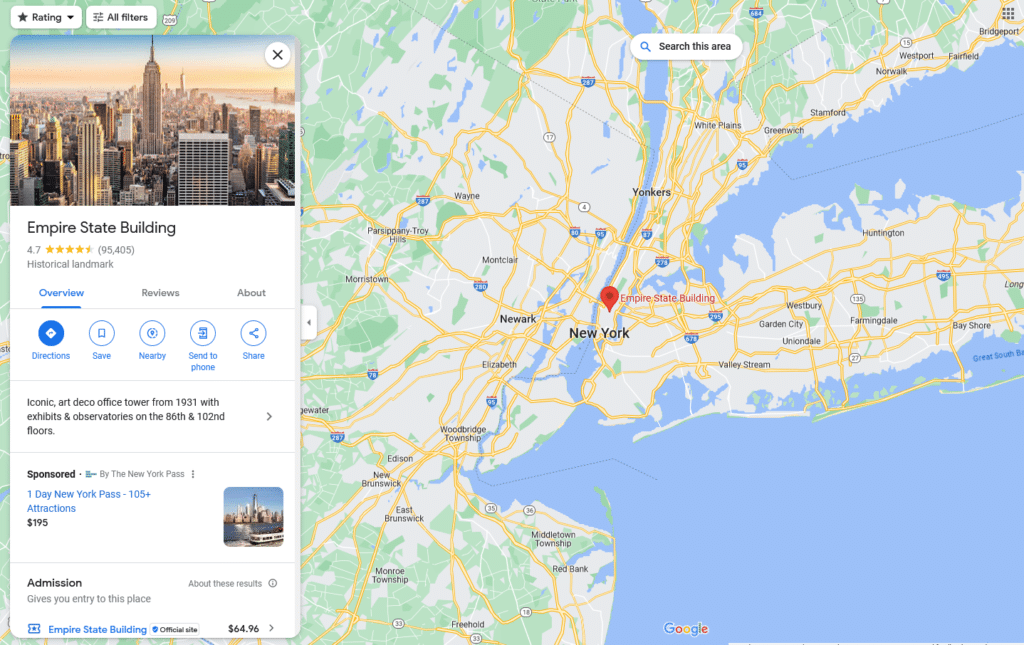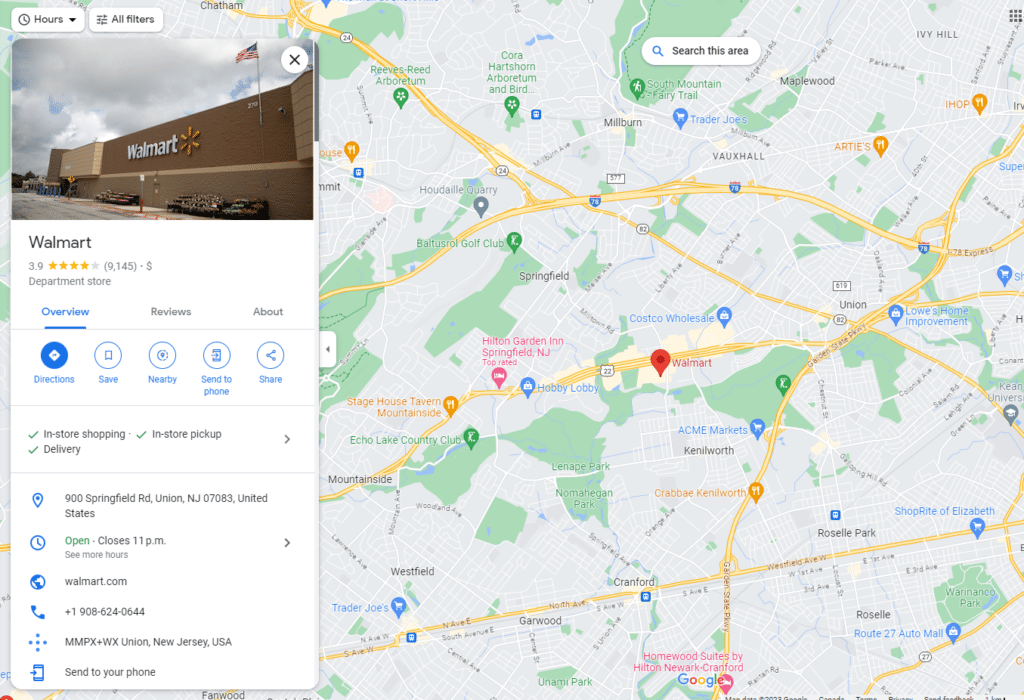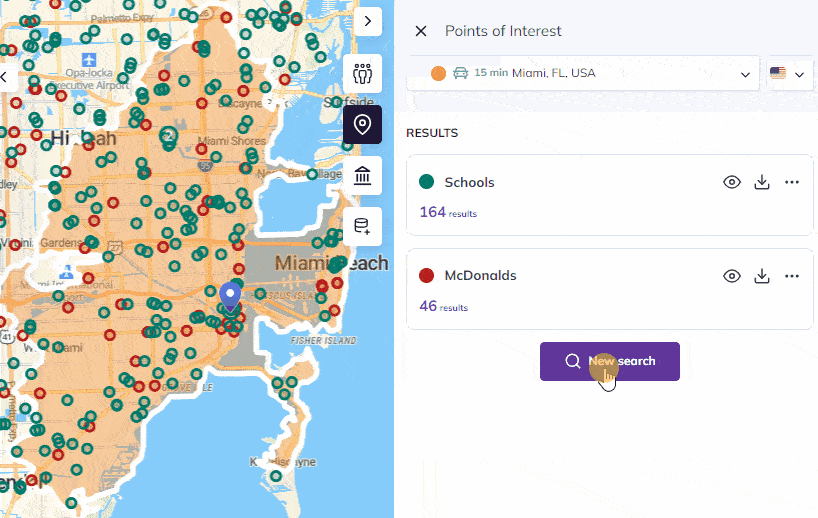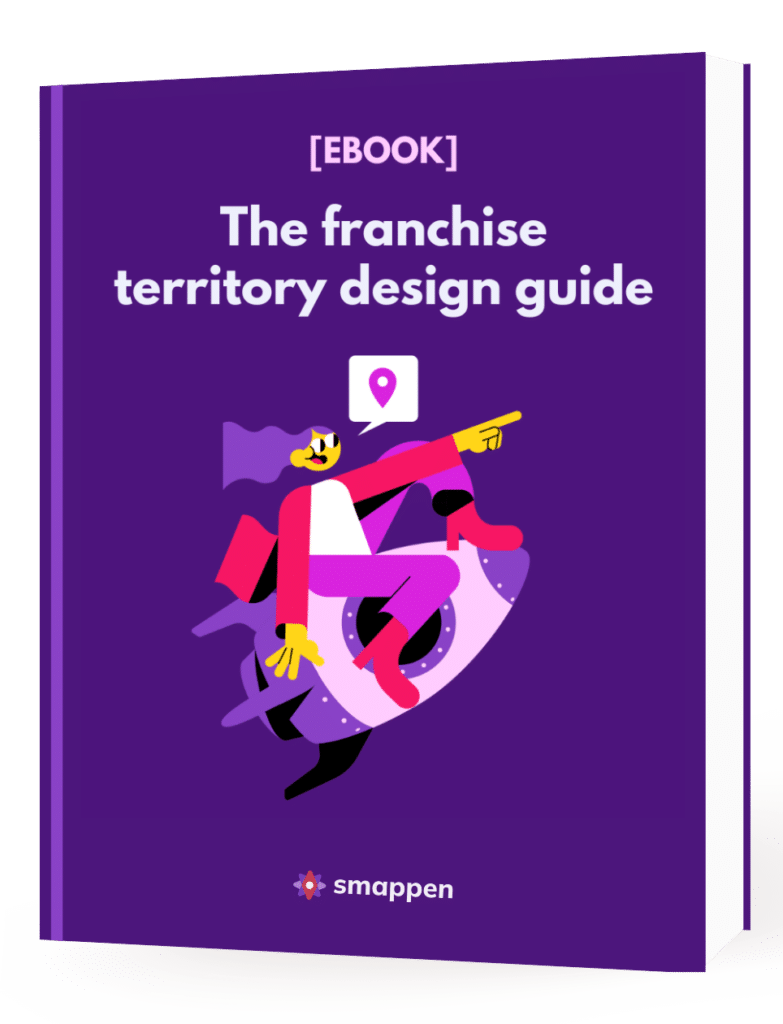TL;DR
What is a point of interest? A point of interest (POI) is a location considered noteworthy based on individual needs or interests. POI data is used by platforms like Google Maps to convert physical locations into digital information, making it easier to explore and find places through apps.
What are some common applications for point of interest data? POI data is commonly used across industries to identify the best locations for launching projects, businesses, or franchises, with additional applications tailored to each sector’s needs. This article explores specific use cases in industries like retail, tourism, and real estate, and highlights apps that utilize POI data for navigation, travel, events, dining, and online shopping.
How Smappen uses point of interest data? With point of interest data, Smappen helps you assess competitors, understand local markets, and choose the perfect location for your next store, marketing campaign, or coverage area.
Points of interest (POIs) are more than just map markers. Discover how they drive navigation, business strategies, and everyday decisions.
What is a point of interest?
A point of interest (or POI) is defined pretty simply as any place someone might find interesting. Depending on the need, these points can be interesting for a bunch of different reasons. For a tourist, a hotel, a theatre, or a nice restaurant are all examples of points of interest. For someone looking to buy a house, a gym, a school, and a doctor’s office would be points of interest. Basically, POIs can vary greatly depending on who you are and what you’re looking for, but they all have something in common; they’re locations that are particularly noteworthy.
What is point of interest data?
Point of interest data is what platforms like Google Maps use to help you find the places you’re looking for. They turn physical locations from the real world into data that can be displayed in apps and other software. That data can include an address, pictures of the location, reviews, and even ticket or menu prices.
Point of interest data is usually collected in a POI database, which gives developers access to this precious data for their own projects.
What does a point of interest look like?

A point of interest can look pretty different depending on the platform you’re using to look it up — but you’re probably most familiar with Google Maps.
In the example above, you’ll see that we’ve looked up the Empire State Building, and Google Maps automatically opens up a panel full of data for this famous landmark. See how a point of interest, pulled from a database plump with data, turns a simple landmark into a ton of useful data? Since Google Maps is primarily made for personal use — and the Empire State Building is a tourist attraction — most of the data you get here is aimed at tourists. Admission prices, tours that include the landmark, and, of course, reviews from other tourists. But point of interest data from Google Maps can be useful for businesses too.

Here’s an example of a point of interest in retail; in this case, Wal-Mart. While at face value, it might seem like this is only useful to customers, there are some bits of data that’s incredibly useful for retailers when researching the competition. Data like:
- Opening hours: If you’re opening a new store in a competitive area, researching points of interest can give you crucial information when picking your store’s hours.
- Busiest times: Google Maps has a handy chart that’ll show you when a point of interest is most busy. That can help you make important staffing and resource management decisions.
- Customer reviews: Having direct access to what your potential customers think of the competition is a huge asset. Know where your competitors are faltering and you can do more to make your business stand out.
Having access to a free database of point of interest data like Google Maps isn’t just great for retail. Here’s how that data can be useful across all sorts of industries.
What are some common applications for point of interest data?
While an app like Google Maps is an obvious example of how point of interest data is used, it can do a whole lot more throughout different industries. There is one use that’s common among all industries, though: finding the best place to start a specific project, business, or franchise. Let’s look at other applications for POI data across a few industries.
Retail
As you’ve seen, the retail world is the best example of how points of interest can be used for starting a business or opening a new site for a franchise. Whoever’s in charge of making this kind of decision will use points of interest to gauge how much competition they’ll have to deal with in a certain area, how much foot traffic they can expect, and how accessible their new location will be.
Tourism
Both tourists and the businesses that cater to them use point of interest data extensively — often without realizing it. Before even traveling to their destination, tourists will look for the best place to stay, often by using a potential hotel’s location to find nearby attractions, restaurants, and other locations. Once they’re there, they’ll use a similar process to plan out their route, trying to group as many nearby attractions together.
Governments
Governments, be they municipal, state, or national, need to use POI data for all sorts of projects. Since they have a hand in managing a variety of important services — from supplying water to managing construction projects — they need to keep a close watch on specific POIs. For example, a gas line is a pretty important POI for a construction project that involves drilling through concrete.
Real estate
Before kickstarting a real estate project, construction companies, investors, and property management companies will look into POIs near where they’re hoping to build. If they’re building a residential building, they’ll look into nearby amenities, such as grocery stores, schools, gyms, and the like. For commercial properties, they might look at points of interest like highways and parking garages.
Transportation and logistics
In this industry, POIs are all about saving on cost and optimizing potential routes. Let’s take Amazon as an example here. An Amazon distribution center is an example of a POI that’ll be taken into account when planning routes, but so is a gas station, a highway, and a residential neighborhood.
Finance
Private equity firms and asset management companies often handle the investment of millions of dollars for their clients in companies, real estate, and more. Points of interest can help an asset manager evaluate the suitability of a particular location (like a brand new strip mall) for a real estate investment or the viability of a business they’re looking to invest in. This kind of data is also useful for analysis of existing investments.
Telecommunications
Telecommunications networks are massive, complex infrastructure projects, and they’re absolutely essential to just about every industry. That makes any telecommunications project, from placing new transmission towers to upgrading aging equipment, a high-stakes endeavor. Point of interest data is just one example of the data professionals in this field will use to research their projects.
5 examples of apps that use point of interest data
Software developers use point of interest data to create all sorts of apps that turn physical locations into useful information. Here are just a few examples.
- Navigation apps: Google Maps is the textbook example of an app that uses point of interest data to make your life easier, whether you’re looking for a particular place to eat or just trying to get around town.
- Travel apps: A travel app like TripAdvisor uses POI data to recommend attractions, restaurants, and more to tourists.
- Event apps: Are you a fan of live events? Apps like Eventbrite aren’t just for getting thickets. They also use POI data to recommend local events to you when you use them.
- Food and drink apps: If you’re a foodie, you’ve probably used apps like OpenTable or UberEats to either find a great place to eat or get food delivered. These apps use POI data to do this.
- Location intelligence tools: Location intelligence is all about using location-based data to make better decisions. With an app like Smappen, you can use location intelligence and POI data to improve your marketing campaigns, map out your business’s coverage area, and more.
- Online shopping apps: Whether you’re ordering groceries or preparing your hardware store order before you swing by, these apps use point of interest data. That helps ensure you’re shopping at the store that’s closest to you, and that the location actually has what you want in stock.
How Smappen uses point of interest data
Smappen is a location intelligence application that’s all about helping you make the best decisions you can with the best data available. With this easy-to-use but robust tool, you can optimize the logistics of your transportation business, choose the best location for your next point of sale, transform your local marketing strategies, and more.

With point of interest data, Smappen can drive all sorts of initiatives by giving you info on potential competitors, helping you size up local markets, and ensuring you pick the best spot for your next store, marketing initiative, or coverage area.
You can sign up for a free Smappen account here to try it out.
Interesting…
Points of interest data is so widespread that you often use it without realizing it. Whether you’re looking up your destination on Google Maps, trying to find a place to eat, or doing market research, point of interest data is essential. With a tool like Smappen, you can turn that data into powerful information that completely transforms your marketing and logistical efforts.

